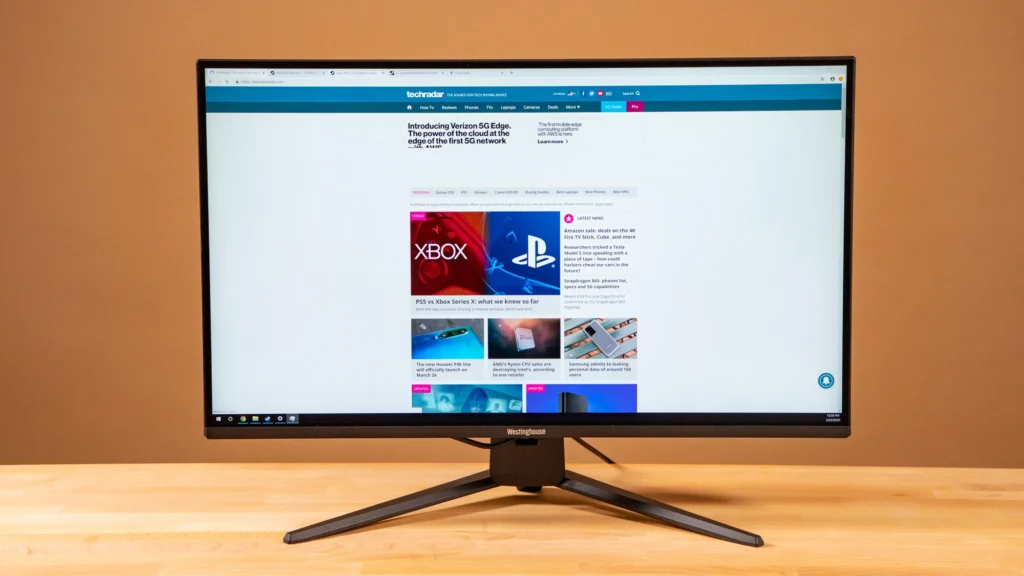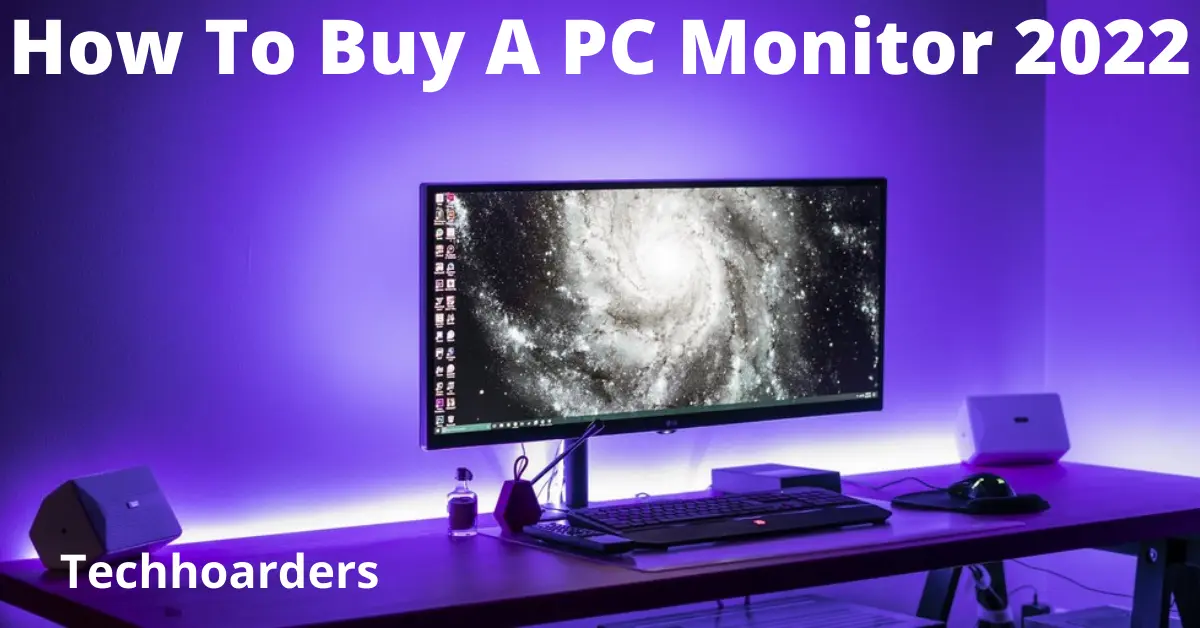PC Monitor gaming has evolved into a worldwide industry, with professional gaming circuits and legions of fans. Gaming PCs may or may not be built by gamers themselves, but gaming monitors must be chosen by gamers. Taking it a step further, professional gaming tournaments use specialized gaming monitors to ensure the best gaming experience for their players.
Quick monitor shopping tips
If you’re a gaming enthusiast, first take a look at gaming monitor reviews. If you’re a professional gamer, these gaming monitor reviews should be your baseline reference point from which to build or start with. For the rest of us who are buying gaming monitors for general use, these gaming PC monitor reviews can give us insights on what we should expect from gaming monitor performance and specifications. The following guidelines may also help:
A gaming monitor with TN (twisted nematic) technology is preferred by gamers because it offers quick response times – keeping up with fast-paced games – and has no ghosting issues. But its colours tend to fade when viewed at an angle.
A gaming PC monitor with IPS (in-plane switching) technology is preferred by pro-gaming tournament organizers because it provides a more natural picture with better viewing angles. However, its response times can be slower and ghosting issues are common.
Gaming monitor resolutions must depend on your gaming PC’s capabilities. Full HD 1080p gaming PC monitors are best for mid to high-end gaming PCs, while gamers who own low-end gaming PCs should opt for a gaming monitor with a lesser resolution such as 720p or even 480p.
For gaming monitors used in professional gaming tournaments, the refresh rate should have no upper limit – when coupled with compatible GPUs, these PC monitors could go up to 240Hz or even higher. In other words, don’t buy a gaming monitor that has a refresh rate lower than 144Hz.
To reduce motion blur during gaming, gaming monitors with adaptive refresh rates such as NVIDIA’s G-Sync or AMD’s Freesync technologies are recommended. Be aware of additional costs on top of the price of the gaming monitor when deciding whether or not to get one with this feature.
With curved gaming monitors, you get more immersive gaming experiences thanks to their wide field of view and increased viewing angles. But many gamers don’t seem to notice any difference between flat screen and curved screen gaming monitors in terms of performance so your choice here boils down to personal preferences.
What resolution do I need for gaming?
For the best gaming experience, gaming monitors should be used with gaming PCs that can handle Full HD (1080p) resolution gaming. That means, don’t buy gaming PC monitors with lower resolutions such as 720p or 480p if you own a gaming PC capable of running games at 1080p.
What kind of panel do I need? TN vs. VA vs. IPS
Gaming monitors are available in three main types of panels: TN (twisted nematic), VA (vertical alignment), and IPS (in-plane switching).
TN-type gaming monitors tend to have the best response times but their colours fade when viewed at an angle. At the same time, they are also less likely to have ghosting issues so if you want a quick gaming response, then gaming PC monitors with TN-type panels are the way to go.
IPS-type gaming monitors are preferred by pro-gaming tournament hosts for their natural picture qualities but they too have slower response times and ghosting issues at certain angles. Moreover, IPS gaming monitors also tend to cost more than their TN counterparts.
Gaming PC monitors: Which features matter?
When it comes to gaming performance, you’re better off comparing gaming monitor reviews than checking out technical specifications because some of them may not always reflect the actual gaming experience. For instance, many gaming monitor reviews say that CRT displays offer superior dynamic contrast ratios compared with LCD displays but in reality, you will never be able to see this advantage during gameplay. Under normal gaming conditions, gaming PC monitors with VA-type panels have better contrast ratios than those with TN-type panels but it still falls short of what you get from a gaming monitor with an IPS panel.
On the other hand, gaming monitor reviews also say that TN panel gaming monitors use inferior RTC (Response Time Compensation) technologies compared with gaming PC monitors using VA and IPS technologies. Well… both TN and VA gaming monitors offer similar gaming experiences – no problems working on dynamic pictures – while IPS gaming monitors end up having slower response times and poorer performance when rapid picture changes occur such as during high-action gaming sequences.

What should my gaming monitor’s refresh rate and response time be?
For gamers, 60Hz is already enough to eliminate screen tearing and ghosting. Compared with gaming monitors with lower refresh rates, gaming PC monitors with higher refresh rates have better fluidity – offering a smoother gaming experience – but this shouldn’t be the only factor to base your buying decision on.
In general, gaming monitors with 120Hz or 144Hz should suffice for most gamers. But if you happen to have a powerful gaming PC capable of wowing demanding gamers, then gaming PC monitors with high-refresh rates such as 165Hz should work well for gaming at 1440p resolutions.
The thing is, graphics cards will become obsolete within a few years so a gaming monitor that can keep up with rapidly changing hardware specs won’t hurt. The bit-depth required depends on the size of the gaming monitor you choose.
1366 x 768 gaming monitors offer the highest bit-depth of 8-bit (or 16.7 million colours) but unless gaming on a very large display, we suggest that gaming monitors with 1920 x 1080 resolution offers just enough quality for gaming and it’s available on all size gaming monitors.
Do I need an overdrive or motion blur reduction?
Overdrive applies voltage to move liquid crystals faster and thus improves response times and reduces ghosting effects during gaming. Overdriving is particularly effective in driving twisted nematic (TN)-type gaming displays at high refresh rates such as those offered by 144Hz gaming monitors so if you want nothing less than pixel perfection during action-packed high-resolution gameplay, then gaming monitors with gaming displays using this technology is your best bet.
By the way, it’s important to turn off overdrive on gaming PC monitors at 60Hz because you will get ghosting effects.
Motion blur reduction technologies such as NVIDIA’s G-Sync and AMD’s FreeSync are designed specifically for gaming so they come in handy when gaming on gaming monitors with higher refresh rates of 120Hz or 144Hz. But if your game is only at 60Hz then there’s no need for motion blur reduction technologies since its purpose is just to compensate for screen tearing that occurs while gaming at high refresh rates where the graphics card cannot keep up with the monitor.
What’s a good gaming PC Monitor?
Ideally, gaming monitors are the only displays you need since they are fine-tuned for gaming. But if gaming is not your primary purpose or one of your secondary purposes, then find yourself a monitor with excellent gaming specs but more on general use PC monitors. Excellent gaming specs on a gaming monitor include high refresh rates, low response times potentially using overdrive technology, and good contrast ratios to showcase vibrant colours while providing deep blacks during dark scenes.
General use monitors: Which features matter?
If gaming is not your primary purpose or one of your secondary purposes, then find yourself a monitor with excellent gaming specs but more on general-use monitors. Excellent gaming specs on a gaming monitor include high refresh rates, low response times potentially using overdrive technology, and good contrast ratios to showcase vibrant colours while providing deep blacks during dark scenes.
What bit-depth do I need?
The bit-depth offered by gaming monitors is similar to those found in gaming PCs so if you have no plans of upgrading them for several years then go with 8-bit (or 16.7 million colours) which offers the highest quality possible at the moment. But if you happen to have a powerful gaming PC equipped with NVIDIA’s GeForce GTX 1080 graphics card then gaming monitors with 10-bit (or 1.07 billion colours) are ideal for gaming at high resolutions since it offers the same bit-depth as the graphics card itself.
Bottom Line
So there you have it, a monitor buying guide that can help you make an informed decision when choosing gaming monitors or general-use monitors! This article is here to give you insights on gaming monitor specs but doesn’t let it dictate your choice of gaming monitor because this is something only you can do by checking out customer reviews and answering some important questions before making your purchase. Happy gaming!
